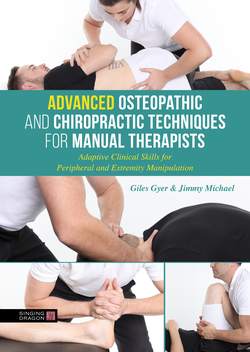Читать книгу Advanced Osteopathic and Chiropractic Techniques for Manual Therapists - Giles Gyer - Страница 24
На сайте Литреса книга снята с продажи.
Current theoretical basis
ОглавлениеSpinal manipulation, by definition, is a specific form of manual therapy; hence, it theoretically adheres to the same philosophy and principles of spinal manipulative therapy. Unlike physicians of the conventional medical system, therapists of spinal manipulation treat their patients with a holistic approach – as a unit of body, mind and soul. They consider the body as a whole integrated organism in which all parts function interdependently, and prioritise spinal integrity as an indicator for the wellbeing of an individual. Hence, manual therapists believe that the good health of a person depends on the smooth functioning of all structures in the body, including bones, muscles, tendons, ligaments and organs. By manipulating a patient’s muscles or joints, therapists tend to aid the body’s self-healing ability, correcting the structural anomalies (Di Fabio 1992; Vickers and Zollman 1999).
Several studies have confirmed that manipulation of the spine can influence some organ functions (Bakris et al. 2007; Budgell 1999; Hawk et al. 2007). However, it is not yet known how spinal manipulation affects visceral function, and whether these effects are clinically relevant in the treatment of visceral diseases. Most of the early theories concerning the effect of manipulation on the visceral system are largely focused on vitalism. Recent theories propose that all organs and structures of the body slide and glide with an interconnected synchronicity, as the whole body is enveloped by an uninterrupted network of connective tissue known as fascia (Hall 2012). Accordingly, the visceral system depends on this synchronicity to function smoothly. In healthy individuals, this harmony remains stable regardless of our body’s endless variations in motion. But when the synchronicity in movement is affected due to formation of adhesions or abnormal muscle tone, it results in an erratic tension between organs, and ultimately limits the body’s normal range of motion. This, in turn, leads to disease and dysfunction of various systems of the body.
Therapists of spinal manipulation claim to correct this disharmony by first locating the source of the problem through palpation, and then realigning changes in the biomechanical dynamics (e.g., position and movement faults) by manipulation. However, many critics of spinal manipulation have rejected such a claim, since there is no direct neural connection between the spine and visceral system. Some have even remarked that the claim is completely unrealistic, arguing that visceral tissues do not depend on spinal nerve root signals to run themselves. In addition, organs could function smoothly on their own, even if a spinal nerve root is cut. Hence, the critics mainly argue that there is no justifiable reason that spinal manipulation can address visceral disorders. In support of this argument, they also say that spinal manipulation has a valid concept in treating musculoskeletal disorders, as musculoskeletal structures rely on the nerves that pass between vertebrae (Ingraham 2017).
